You've reached the central hub for Misty’s Challenge! Here you’ll find up-to-date info on my courses, their associated missions, and the brave challengers trying to clear them all (with the occasional side of Mario discourse.)
Don't wanna be here? Send us removal request.
Text
Ah, hey, I’d been meaning to get to you on this. I looked up The Incredible Machine after reading your reply, and I loved it. As for your Breakfast Machine game, I can say that Rube Goldberg machines in games appear to go a long way back. Here’s one dating all the way back to 1983:
youtube
It’s really no surprise that contraptions like these pop up as often as they do in videogames. They are, essentially, automatons within automatons.
The playlist this video is from was a recording of TV’s TV, a weird mid-’80s Japanese television block with a technological theme. It ran clips of videogames, simulations, CGI, skits about a man interfacing with his computer, remixes of news footage, and more, all late at night. Going off your blog, it seems like something you might like to look at sometime.
Don’t Move.

This is Haru Usasa.
She’s a level designer for Super Mario Maker. At the time I first found her, she’d been ranked the #1 designer on the network by star count, the #1 “maker” as they call it there.
That means a lot. I think for any of us it would be an honor to have as many as a hundred or even a thousand stars. I think for many of us it would be an honor to any stars at all. Usasa has a million stars, a million stars and counting, and just to hammer that bit home, just to drive in the scale of it, consider that at the time of posting, she has more stars, and more medals, than the next two highest-ranked designers combined, outstripping the greater of those two by a 700,000-star lead.
And that? That’s the low estimate. The real numbers are even higher.
Haru Usasa is, to put it bluntly, in a class all her own. She is, to put it plainly, a h*cking legend.
And also? These are the levels she makes:
youtube
Ta-da! It’s an automatic.
Some of you are probably cringing right now, but for those of you who don’t know, don’t mind, and would like to know more: Automatic levels (or automatic “courses,” to use the Super Mario series’ exact—and frankly, arbitrary—terminology,) are courses that play themselves, using objects and enemies to propel Mario forward with little to no input from the player. They first bubbled up out of the Super Mario World modding community (as did so many other aspects of the SMM scene that I am dead certain there’s an argument to be made that the original 1990 release is to SMW what Vanilla is to Doom,) starting with a series of musical courses set to megamixes from Nico Nico Douga.
An automatic, by the way, is also a type of gun, which I think is pertinent to what it feels like to look at one of these courses, or to play them.
And speaking of that, here’s an example:
youtube
Boom.
At this point, they’re practically a genre in their own right, but they’ve become a bit of a base breaker in the SMM community, due in large part to their growing ubiquity on the Course World servers. Some of us could take ‘em or leave ‘em, some of us love them, and many of us write them off derisively, as cheap star grabs peddled by lazy amateurs. (Which, I mean, aren’t we all amateurs here?)
But me, personally? I think Usasa here deserves every star she’s got.
This is the sort of claim you just have to put into context, so first let’s take a moment to talk about Sonic. Don’t bother mentioning the irony, I already know. But I promise, I am going somewhere with this.
People still have fond recollections of the Genesis-era Sonic games. The runaway success of a deliberate throwback like Sonic Mania is a testament not only to the strength of those recollections but also to the idea that, in many ways, the games still hold up today. But there is still a lot of contention about just what made them work, about what their essence was, beyond second-order issues like “multiple routes” or “gameplay-to-story ratio.” Some even argue that early Sonic wasn’t about speed so much as it was about platforming, pointing out, correctly, that these games weren’t nearly as fast as their successors would become.
But what isn’t talked about often enough when discussing what made those games special was their physics, and the way that Sonic was, in the end, all about its physics. Even Sonic’s speed only really mattered to the extent that it let the game express its physics.
Sound like a hard left? I mean, don’t get me wrong, Sonic was fast. But he wasn’t boosting Blue Falcon fast. He wasn’t even boosting blue hedgehog fast. No, Sonic speed had always been a darting speed, an agile kind of speed, a portal fling-swing kind of speed. There’s a post going into that difference in detail, and there’s a lot of detail to go into here, but this quote sums up the gist of it:
“Which of these moves faster, a commercial airliner or a roller coaster?
“Alright, now which one of these feels faster?
“[…] It’s pretty obvious that, although the airliner is going to (sic) faster for longer, the roller coaster is what feels the fastest. The reason for this phenomenon isn’t speed, however. It’s acceleration, which we can define as a change in speed, or a change in direction, or both (for short, a change in velocity.) The reason that the airliner feels almost motionless in mid-flight is that it builds up speed slowly, turns even more slowly, and gives your body plenty of time to adjust, whereas the roller coaster speeds up, slows down, lunges, dives, and whips around corners and corkscrews faster than your body can adjust.
“Which, coincidentally, sounds like something out of an ad for an old Sonic game.”
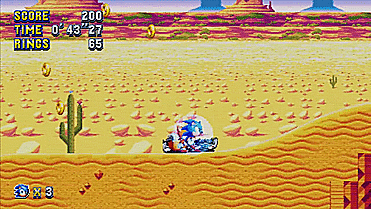
This is a big part of what made a paid fan project like Sonic Mania feel so much more authentic than Sega’s own in-house attempts at a Genesis homage, which faithfully recreated the musical style and visual motifs of those games but often treated their physics like an afterthought. The system of momentum that powered the games might’ve made platforming a chore, but they’re also what made loop-de-loops and corkscrews click: You could see the strings. You knew how this trick worked, and yet it amazed you regardless, despite this, because of it, because you could marvel at the intricacy of a system capable of stretching itself this far. You didn’t always gain much speed at any given time, but you didn’t have to; the thrill of the speed you did gain emerged from the yawning gap between your standard speed and the speed you could potentially achieve by manipulating this system to your advantage, by capturing that fire, by bottling that lightning.
Many will say that the reason reaching high speed felt so satisfying, in the end, is because “you had to work for it,” because it had to be “earned.” And while that is one way to frame it, I’d like to suggest, instead, that what made that dizzying acceleration worth watching was that it was always authentic: never scripted, never automatic, never anything more than an inevitable consequence of the game’s laws as they were written, carried out to the letter. Where later Sonic games would say with their on-rails sections: “Look at how fast Sonic is going,” the Genesis games said something fundamentally different:
youtube
“Look at the power, the raw kinetic potential, contained in these slopes and inclines. Look at what you can do, what you can create, and with nothing but a little weight, a little gravity, and a little push.”
It’s Phoenix Wright interpreting Newton. It’s you, as the marble in a Rube Goldberg Machine.
It’s the awful palpable potency of a loaded automatic.

I don’t…have to explain that last pun, do I? No? Okay, good. Then we can get back to Mario, because it’s the exact same thing for Mario.
The automatic courses in Super Mario Maker actually differ from the ones you see in Super Mario World on two key points:
1. None of them play music, and if there is one that does, I haven’t seen it. In fact, the automatic music course that these new courses sprung from appears to have split off into two separate genres, automatic and music. To wit, the top two course creators are an automatic maker and a music maker, in or out of that order from week to week. (The only other million-star maker is a musical course designer known only as Ochagama.) Though there are few courses, if any (again, I know of none,) that re-unify the best traits of both genres, the problem isn’t laziness or lack of imagination. Instead, it’s that Super Mario Maker’s course size limit is below that of any music mod I’ve ever seen. There’s a strict object limit, somewhere around 100 for enemies and obstacles like 1-Way doors and trampolines (though there is a separate and significantly higher limit for static blocks and coins.) This all leads to the second point:
2. Super Mario Maker’s automatic courses are DENSE. Where the old automatics chugged right on ahead to keep in time with the music, these courses bounce back and forth across the stage like a pinball. Rather than stretch 100 objects across ten screens, these courses pack as much as possible into a small space that folds over on itself to produce a spectacle of excess. It is a bursting, exploding thing, but it’s an explosion more like a blossom than a bomb. To cut it down to simple talk, it’s kineasthetic sakuga.

Super Mario Maker is, essentially, a sandbox game, like Minecraft. You switch back and forth between creative and goal-oriented play, and in either case your goal is to explore, engage with and appreciate the complex systems at play, the systems that allow the game to be what it is. Play is only valuable inasmuch as it helps you to do this.
It’s often complained that automatic courses aren’t “real” courses because you can’t play them, which echoes similar complaints in the last several years that games like Dear Esther aren’t “real” games because your agency is limited within them. Automatic courses seem like an extreme version of this issue: You’re not allowed do to anything, and even attempting to act, save for the few cases in which you are expressly asked to do so, is punished harshly. To a certain type of player, this approach to design is bound to come off as inconsiderate, even offensive.
The compliments that are usually given to these courses, on the other hand, typically come down to the amount of effort it must’ve taken to build them. And okay, yes, true, there’s a reason Usasa takes about a month between each upload, but I think that these courses can be appreciated on their own merits, on their merits as experiences. More than just cheap popcorn fodder, the automatic course is a surprisingly poignant example of a videogame, or a section of a videogame at least, without a player, as the “player” is traditionally understood, a non-player-centric space in which the only necessity is that the player be present to “perceive play,” as Mattie Brice puts it in “Death of the Player.” And even with that you could just, I dunno, watch YouTube or something.
Automatic courses do the same thing attract modes do for arcade games: They say: “Look at what this game can do.” Only this is different, because now you’re there and you can attest to the fact that the course is moving on its own. All you really need is to be there. Be there, and be very still, and you just might get to watch the game sing.
If you enjoyed reading this, here are some courses you may be interested in:
“全自動マリオカート Automatic Mario Kart“ by ササエタマエ. A screenshot from this course was used in the essay. It’s the one with the red and black shells. ID: 635C-0000-0045-AF89.
“ ↑ボタンを押し続ける鍵ドア半自動 Keep ↑” by うささ. Crams all the activity of an automatic into the span of a single screen. ID: 1747-0000-0259-926D.
“ 36回楽しめる自動マリオ 36 Auto patterns“ by さぼ. Allows you to take a different route through the course depending on which buttons are held down from the start. There are 36 routes total. It’s…kiiind of incredible. ID: 1883-0000-02C1-89AC. (Here is a video showing all possible routes.)
*ECK
121 notes
·
View notes
Photo
It’s actually not that difficult to imagine that this is how the mechanic was implemented originally. Players in 1995 weren’t accustomed to third-person 3D or analog sticks, so a way to recover from minor silly mistakes like sliding off a ledge would have been a plus. And it almost balances out, since now in order to die, you’d have to be someplace genuinely dangerous, like around enemies.
I say “almost” here, because the coin system has a clear advantage that may have contributed to its implementation later on: You have to look for the coins. The former system, although convenient, would’ve been easy to break by just waiting out the meter every time you fell down, or running around like a chicken every time an enemy hit you. But now that health is tied to coins, you have to strike out into that scary 3D world and work to get it back. Coins are plentiful enough that you can still recover from stupid mistakes (and they even add infinite-use spinning hearts at points where you’re liable to fail several times,) but this system encourages active play and exploration, sort of like hiding your sword in the first Zelda.
There was a time when I didn’t understand any of this. I’d be like “Why is your health tied to coins. There are too many coins. This game is too generous”
...after messing up a wall kick for the 3rd time.
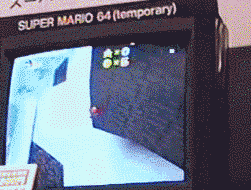
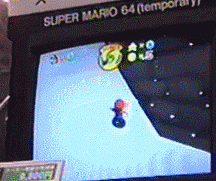
The prerelease build of Super Mario 64 showcased at the Shoshinkai 1995 expo contained a feature absent from the finished game: automatically regenerating health. In this footage, we can see that after taking fall damage and reducing his health to 4, Mario regenerates health at a rate of one unit every few seconds until it is 8 again. (Source)
909 notes
·
View notes
Text
one thing i think is interesting, as someone who basically grew up playing video games non-stop, is how some types of video game just don’t gel with people
like, it’s easy to forget that, even though i’m pretty bad at most games, that my skill at handling video games is definitely “above average.” as much as i hate to put it like this, i’d say my experience level is at “expert” solely because I can pick up any game controller and understand how to use it with no additional training.
a friend of mine on twitter posted a video of him stuck on a part of samus returns. the tutorial area where it teaches you how to ledge-grab. the video is of him jumping against the wall, doing everything but grabbing the ledge, and him getting frustrated
i’ve been playing games all my life, so i’d naturally intuit that i should jump towards the ledge to see what happens
but he doesn’t do that.
it’s kinda making me realize that as games are becoming more complex and controllers are getting more buttons, games are being designed more and more for people who already know how to play them and not people with little to no base understanding of the types of games they’re playing
so that’s got me thinking: should video games assume that you have zero base knowledge of video games and try to teach you from there? should Metroid: Samus Returns assume that you already know how to play a Metroid game and base its tutorial around that, or should it assume that you’ve never even played Mario before?
it’s got me thinking about that Cuphead video again. you know the one. to anyone with a lot of experience with video games, especially 2D ones, we would naturally intuit that one part of the tutorial to require a jump and a dash at the same time.
but most people lack that experience and that learned intuition and might struggle with that, and that’s something a lot of people forget to consider.
it reminds me a bit of the “land of Punt” that I read about in this Tumblr post. Egypt had this big trading partner back in the day called Punt and they wrote down everything about it except where it was, because who doesn’t know where Punt is? and now, we have no idea where it was, because everyone in Egypt assumed everyone else knew.
take that same line of thinking with games: “who doesn’t know how to play a 2D platform game?” nobody takes in to consideration the fact that somebody might not know how to play a 2D game on a base level, because that style of gameplay is thoroughly ingrained in to the minds of the majority of gamers. and then the Cuphead situation happens.
the point of this post isn’t to make fun of anybody, but to ask everyone to step back for a second and consider that things that they might not normally consider. as weird as it is to think about for people that grew up playing video games, anyone who can pick up a controller with thirty buttons on it and not get intimidated is actually operating at an expert level. if you pick up a playstation or an Xbox controller and your thumbs naturally land on the face buttons and the analog stick and your index fingers naturally land on the trigger buttons, that is because you are an expert at operating a complex piece of machinery. you have a lifetime of experience using this piece of equipment, and assuming that your skill level is the base line is a problem.
that assumption is rapidly becoming a problem as games become more complex. it’s something that should be considered when talking about games going forward. games should be accessible, but it’s reaching a point where even Nintendo games are assuming certain levels of skill without teaching the player the absolute basics. basics like “what is an analog stick” and “where should my fingers even be on this controller right now.”
basically what i’m saying is that games are becoming too complex for new players to reasonably get in to and are starting to assume skill levels higher than what should be considered the base line. it’s becoming a legitimate problem that shouldn’t be laughed at and disregarded. it’s very easy to forget that thing things YOU know aren’t known by everyone and that idea should be taken in to consideration when talking about video games.
36K notes
·
View notes
Text
Do it for the ruler of the Underworld.
462 notes
·
View notes
Photo









The skyboxes from Super Mario 64.
7K notes
·
View notes
Text
Don’t Move.

This is Haru Usasa.
She’s a level designer for Super Mario Maker. At the time I first found her, she’d been ranked the #1 designer on the network by star count, the #1 “maker” as they call it there.
That means a lot. I think for any of us it would be an honor to have as many as a hundred or even a thousand stars. I think for many of us it would be an honor to any stars at all. Usasa has a million stars, a million stars and counting, and just to hammer that bit home, just to drive in the scale of it, consider that at the time of posting, she has more stars, and more medals, than the next two highest-ranked designers combined, outstripping the greater of those two by a 700,000-star lead.
And that? That’s the low estimate. The real numbers are even higher.
Haru Usasa is, to put it bluntly, in a class all her own. She is, to put it plainly, a h*cking legend.
And also? These are the levels she makes:
youtube
Ta-da! It’s an automatic.
Some of you are probably cringing right now, but for those of you who don’t know, don’t mind, and would like to know more: Automatic levels (or automatic “courses,” to use the Super Mario series’ exact—and frankly, arbitrary—terminology,) are courses that play themselves, using objects and enemies to propel Mario forward with little to no input from the player. They first bubbled up out of the Super Mario World modding community (as did so many other aspects of the SMM scene that I am dead certain there’s an argument to be made that the original 1990 release is to SMW what Vanilla is to Doom,) starting with a series of musical courses set to megamixes from Nico Nico Douga.
An automatic, by the way, is also a type of gun, which I think is pertinent to what it feels like to look at one of these courses, or to play them.
And speaking of that, here’s an example:
youtube
Boom.
At this point, they’re practically a genre in their own right, but they’ve become a bit of a base breaker in the SMM community, due in large part to their growing ubiquity on the Course World servers. Some of us could take ‘em or leave ‘em, some of us love them, and many of us write them off derisively, as cheap star grabs peddled by lazy amateurs. (Which, I mean, aren’t we all amateurs here?)
But me, personally? I think Usasa here deserves every star she’s got.
This is the sort of claim you just have to put into context, so first let’s take a moment to talk about Sonic. Don’t bother mentioning the irony, I already know. But I promise, I am going somewhere with this.
People still have fond recollections of the Genesis-era Sonic games. The runaway success of a deliberate throwback like Sonic Mania is a testament not only to the strength of those recollections but also to the idea that, in many ways, the games still hold up today. But there is still a lot of contention about just what made them work, about what their essence was, beyond second-order issues like “multiple routes” or “gameplay-to-story ratio.” Some even argue that early Sonic wasn’t about speed so much as it was about platforming, pointing out, correctly, that these games weren’t nearly as fast as their successors would become.
But what isn’t talked about often enough when discussing what made those games special was their physics, and the way that Sonic was, in the end, all about its physics. Even Sonic’s speed only really mattered to the extent that it let the game express its physics.
Sound like a hard left? I mean, don’t get me wrong, Sonic was fast. But he wasn’t boosting Blue Falcon fast. He wasn’t even boosting blue hedgehog fast. No, Sonic speed had always been a darting speed, an agile kind of speed, a portal fling-swing kind of speed. There’s a post going into that difference in detail, and there’s a lot of detail to go into here, but this quote sums up the gist of it:
“Which of these moves faster, a commercial airliner or a roller coaster?
“Alright, now which one of these feels faster?
“[…] It’s pretty obvious that, although the airliner is going to (sic) faster for longer, the roller coaster is what feels the fastest. The reason for this phenomenon isn’t speed, however. It’s acceleration, which we can define as a change in speed, or a change in direction, or both (for short, a change in velocity.) The reason that the airliner feels almost motionless in mid-flight is that it builds up speed slowly, turns even more slowly, and gives your body plenty of time to adjust, whereas the roller coaster speeds up, slows down, lunges, dives, and whips around corners and corkscrews faster than your body can adjust.
“Which, coincidentally, sounds like something out of an ad for an old Sonic game.”

This is a big part of what made a paid fan project like Sonic Mania feel so much more authentic than Sega’s own in-house attempts at a Genesis homage, which faithfully recreated the musical style and visual motifs of those games but often treated their physics like an afterthought. The system of momentum that powered the games might’ve made platforming a chore, but they’re also what made loop-de-loops and corkscrews click: You could see the strings. You knew how this trick worked, and yet it amazed you regardless, despite this, because of it, because you could marvel at the intricacy of a system capable of stretching itself this far. You didn’t always gain much speed at any given time, but you didn’t have to; the thrill of the speed you did gain emerged from the yawning gap between your standard speed and the speed you could potentially achieve by manipulating this system to your advantage, by capturing that fire, by bottling that lightning.
Many will say that the reason reaching high speed felt so satisfying, in the end, is because “you had to work for it,” because it had to be “earned.” And while that is one way to frame it, I’d like to suggest, instead, that what made that dizzying acceleration worth watching was that it was always authentic: never scripted, never automatic, never anything more than an inevitable consequence of the game’s laws as they were written, carried out to the letter. Where later Sonic games would say with their on-rails sections: “Look at how fast Sonic is going,” the Genesis games said something fundamentally different:
youtube
“Look at the power, the raw kinetic potential, contained in these slopes and inclines. Look at what you can do, what you can create, and with nothing but a little weight, a little gravity, and a little push.”
It’s Phoenix Wright interpreting Newton. It’s you, as the marble in a Rube Goldberg Machine.
It’s the awful palpable potency of a loaded automatic.

I don’t...have to explain that last pun, do I? No? Okay, good. Then we can get back to Mario, because it’s the exact same thing for Mario.
The automatic courses in Super Mario Maker actually differ from the ones you see in Super Mario World on two key points:
1. None of them play music, and if there is one that does, I haven’t seen it. In fact, the automatic music course that these new courses sprung from appears to have split off into two separate genres, automatic and music. To wit, the top two course creators are an automatic maker and a music maker, in or out of that order from week to week. (The only other million-star maker is a musical course designer known only as Ochagama.) Though there are few courses, if any (again, I know of none,) that re-unify the best traits of both genres, the problem isn’t laziness or lack of imagination. Instead, it’s that Super Mario Maker’s course size limit is below that of any music mod I’ve ever seen. There’s a strict object limit, somewhere around 100 for enemies and obstacles like 1-Way doors and trampolines (though there is a separate and significantly higher limit for static blocks and coins.) This all leads to the second point:
2. Super Mario Maker’s automatic courses are DENSE. Where the old automatics chugged right on ahead to keep in time with the music, these courses bounce back and forth across the stage like a pinball. Rather than stretch 100 objects across ten screens, these courses pack as much as possible into a small space that folds over on itself to produce a spectacle of excess. It is a bursting, exploding thing, but it’s an explosion more like a blossom than a bomb. To cut it down to simple talk, it’s kineasthetic sakuga.

Super Mario Maker is, essentially, a sandbox game, like Minecraft. You switch back and forth between creative and goal-oriented play, and in either case your goal is to explore, engage with and appreciate the complex systems at play, the systems that allow the game to be what it is. Play is only valuable inasmuch as it helps you to do this.
It’s often complained that automatic courses aren’t “real” courses because you can’t play them, which echoes similar complaints in the last several years that games like Dear Esther aren’t “real” games because your agency is limited within them. Automatic courses seem like an extreme version of this issue: You’re not allowed do to anything, and even attempting to act, save for the few cases in which you are expressly asked to do so, is punished harshly. To a certain type of player, this approach to design is bound to come off as inconsiderate, even offensive.
The compliments that are usually given to these courses, on the other hand, typically come down to the amount of effort it must’ve taken to build them. And okay, yes, true, there’s a reason Usasa takes about a month between each upload, but I think that these courses can be appreciated on their own merits, on their merits as experiences. More than just cheap popcorn fodder, the automatic course is a surprisingly poignant example of a videogame, or a section of a videogame at least, without a player, as the “player” is traditionally understood, a non-player-centric space in which the only necessity is that the player be present to “perceive play,” as Mattie Brice puts it in “Death of the Player.” And even with that you could just, I dunno, watch YouTube or something.
Automatic courses do the same thing attract modes do for arcade games: They say: “Look at what this game can do.” Only this is different, because now you’re there and you can attest to the fact that the course is moving on its own. All you really need is to be there. Be there, and be very still, and you just might get to watch the game sing.
If you enjoyed reading this, here are some courses you may be interested in:
“全自動マリオカート Automatic Mario Kart“ by ササエタマエ. A screenshot from this course was used in the essay. It’s the one with the red and black shells. ID: 635C-0000-0045-AF89.
“ ↑ボタンを押し続ける鍵ドア半自動 Keep ↑” by うささ. Crams all the activity of an automatic into the span of a single screen. ID: 1747-0000-0259-926D.
“ 36回楽しめる自動マリオ 36 Auto patterns“ by さぼ. Allows you to take a different route through the course depending on which buttons are held down from the start. There are 36 routes total. It’s...kiiind of incredible. ID: 1883-0000-02C1-89AC. (Here is a video showing all possible routes.)
*ECK
#super mario maker#mario#game design#a study in smm#designer spotlight#course recommendations#haru usasa#automario
121 notes
·
View notes
Photo

https://supermariomakerbookmark.nintendo.net/courses/3399-0000-0358-7640 Duck, swing, fly! Get into the rhythm or prepare to die!
0 notes
Text
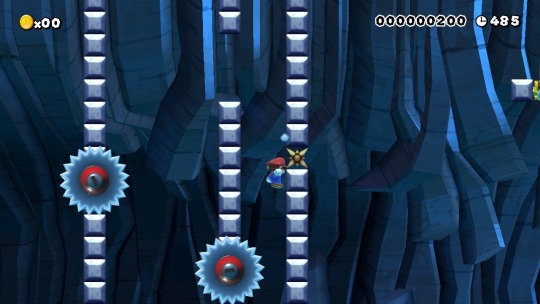
Hey! I dunno if you still use this blog but, like, I played “Nicholas Cave” (all the other ones were gone for some reason.) I liked it, even though there were some parts that didn’t play out the way you were probably assuming they would during planning or playtesting. (For example, I was able to slide all the way down this wall without getting hurt.)
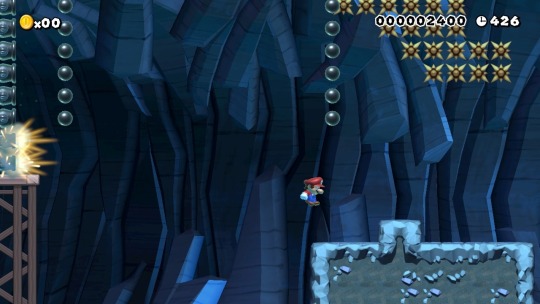
That part with the trick conveyor belt was delightfully shrewd. Staying between the lines was not a use of cannons I was expecting, either, so good on you for that. And to get super esoteric for a moment, the way the wall kick section branches into multiple routes gives a sense of horizontality to a move whose implementation in most Mario Maker courses lacks this to a potentially fatal degree (we’ve only got so much vertical space to work with, guys!) I’m totally stealing it.

Anyway, thanks for making this course! I’m following you now, by the way.
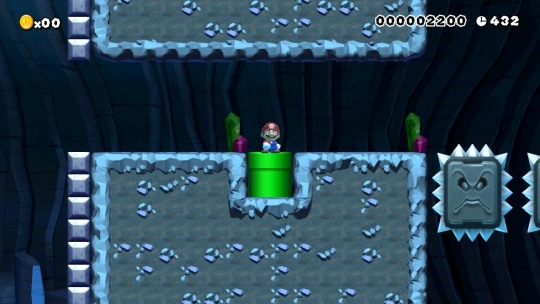
(P.S. Was something supposed to go here?)
If anyone plays Mario maker and wants a level to play, it would make me super happy if you tried one of the levels me and my boyfriend have been working on lately.
Hard wall jumpy ones: Escape from lava lair: 533C-0000-034C-ED29
Perilous path: E860-0000-034D-5019
Nicholas Cave F0B2-0000-034D-7A21
A puzzly one, Mario world style: Peach’s mystery mansion: 39FD-0000-034D-69E1
So yeah if anyone’s interested if would make us very excited to see people play our stuff! :D
1 note
·
View note
Photo
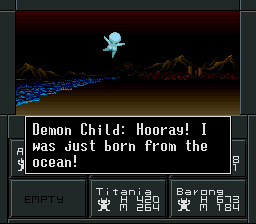
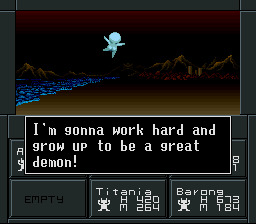
16K notes
·
View notes